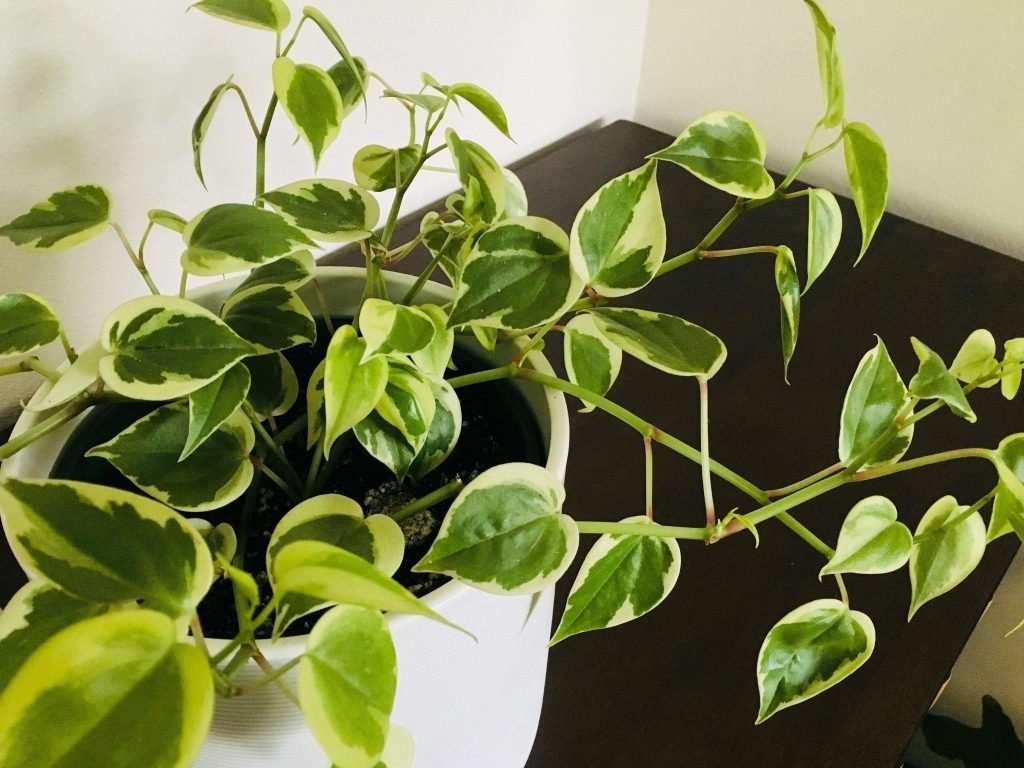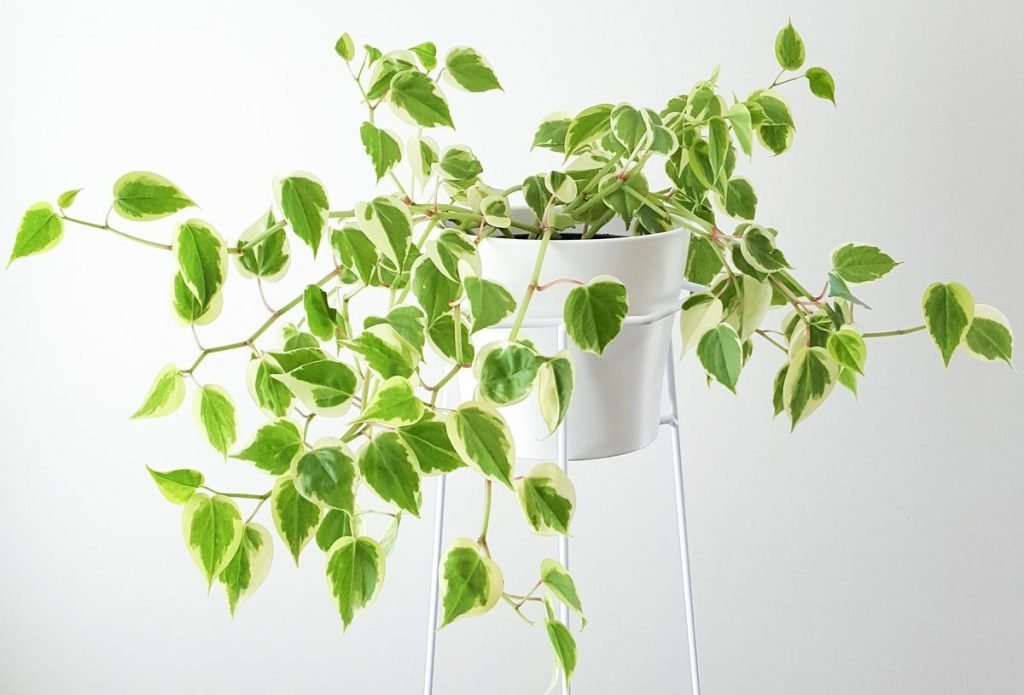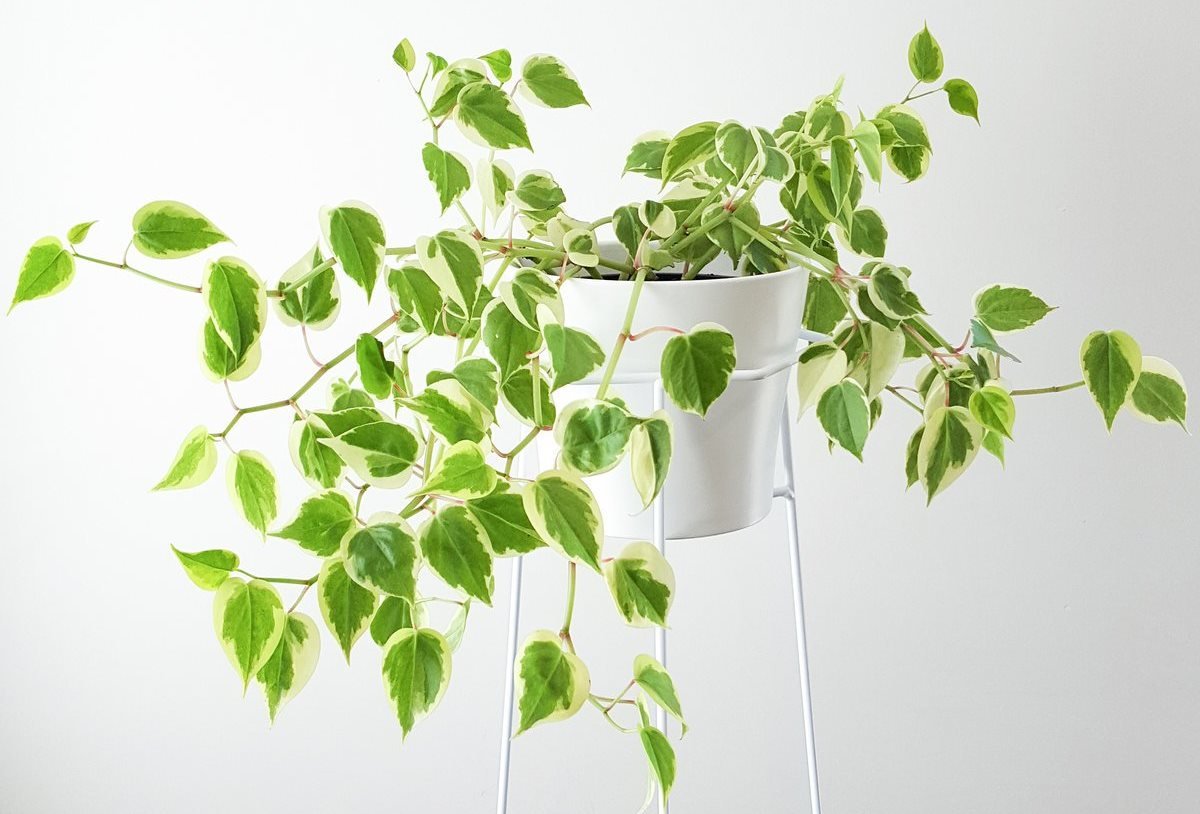Cupid Peperomia Overview
In this detailed guide, we delve into the secrets of nurturing and propagating the Variegated Cupid Peperomia, or as botanists know it, Peperomia scandens ‘Variegata’ a plant that has captured the hearts of indoor gardening enthusiasts with its charming foliage and easy-going nature.
The Cupid Peperomia, with its heart-shaped, creamy variegated leaves, adds a touch of whimsy and color to any indoor space. Its cascading growth habit makes it an ideal choice for hanging baskets or high shelves, where its vines can gracefully trail down, creating a captivating display of greenery. Known for its resilience and adaptability.
So, whether you’re looking to enhance your living space with more greenery or seeking practical advice on caring for your Cupid Peperomia, this guide is your go-to resource.
| Attribute | Detail |
|---|---|
| Common Name | Cupid Peperomia |
| Nicknames | Radiator Plant, False Philodendron |
| Botanical Name | Peperomia scandens ‘Variegata’ |
| Family | Piperaceae |
| Plant Type | Epiphyte, Perennial |
| Mature Size | Varies; generally up to 12 inches tall and wide |
| Sun Exposure | Bright to medium indirect light |
| Bloom Time | Seasonal |
| Flower Color | Greenish or cream |
| Hardiness Zones | Typically grown as a houseplant |
| Native Area | Central and South America |

Care Guide for the Variegata Cupid Peperomia
Light
The variegated Cupid Peperomia, Peperomia scandens ‘Variegata’, flourishes in a world of balanced light. This charming plant prefers bright, indirect sunlight to showcase its variegated leaves to the fullest. 🌞 Place it near a window where it can bask in ample light but is shielded from the harsh midday sun. East or north-facing windows are ideal locations, offering the gentle light that these variegated beauties crave. Avoid direct sunlight, as this can cause the leaves to fade and lose their vibrant variegation. In darker homes, consider using a grow light to provide your Cupid Peperomia with the light it needs.
Water
When it comes to watering, the Cupid Peperomia prefers a ‘less is more’ approach. Its succulent-like leaves store water, making it more tolerant of under-watering than over-watering. 💧 The best practice is to water your plant when the top inch of the soil feels dry to the touch. Reduce watering in the winter months when plant growth naturally slows. Overwatering can lead to root rot, a common issue in many houseplants. Always ensure the pot has good drainage to prevent excess water from accumulating.
Soil
A well-draining soil mix is the key to keeping your Cupid Peperomia happy. Opt for a mix that’s designed for succulents or create your blend by mixing regular houseplant soil with perlite or coarse sand. This ensures that excess water drains quickly, avoiding the dreaded soggy soil scenario. 🌱 Aeration is crucial for the roots to thrive, so avoid heavy, compact soils that can suffocate the plant.
Temperature and Humidity
Cupid Peperomia enjoys a warm and stable environment, typical of most indoor settings. Aim to keep the temperature between 65-75°F (18-24°C). Avoid placing your plant in drafty areas or near vents, as sudden temperature fluctuations can be stressful. 🌡️
This plant doesn’t demand high humidity, but like many houseplants, it appreciates a boost in moisture levels, especially during dry winter months. If you notice the edges of the leaves becoming brown or crispy, consider using a humidifier or placing a water-filled pebble tray beneath the pot.
Fertilizer
Feeding your Cupid Peperomia can enhance its growth and vitality. Use a balanced, water-soluble fertilizer diluted to half the recommended strength, and apply it once a month during the growing season (spring and summer). 🌼 Avoid over-fertilizing, as this can lead to salt buildup in the soil, potentially harming the plant. In winter, when the plant’s growth slows down, fertilizing can be reduced or stopped altogether until spring arrives.
Growing Guide for Cupid Peperomia
How to Propagate
Propagating the Variegated Cupid Peperomia, Peperomia scandens ‘Variegata’, is a rewarding and surprisingly straightforward process. This task, akin to nurturing the future generations of your beloved plant, can be accomplished through two primary methods: leaf cuttings and stem cuttings. 🌱
- Leaf Cuttings:
- Select a healthy, mature leaf and cut it off with a clean, sharp pair of scissors.
- You can either lay the leaf on top of a well-draining potting mix or insert the cut end into the soil.
- Keep the soil consistently moist but not soggy.
- In a few weeks, roots should develop, followed by new growth.
- Stem Cuttings:
- Choose a healthy stem with a few leaves and cut it just below a node (the point where leaves attach to the stem).
- Place the cutting in a jar of water, ensuring that at least one node is submerged.
- Change the water regularly to keep it fresh.
- Once roots have developed, pot the cutting in a well-draining soil mix.
Propagation is best done in the spring or early summer when the plant is in its active growth phase.
Potting and Repotting
The Variegated Cupid Peperomia doesn’t mind being a bit root-bound, which means less frequent repotting. However, when it’s time for a new home, here’s what to do:
- Pot Selection:
- Choose a pot that is slightly larger than the current one and has good drainage holes.
- Terracotta pots are a great choice as they allow the soil to breathe and help prevent waterlogging.
- Repotting Steps:
- Gently remove the plant from its current pot and shake off loose soil.
- Inspect the roots and trim any that are dead or overly long.
- Place a layer of fresh potting mix in the new pot and set the plant in place.
- Fill around the roots with more potting mix and water thoroughly.
Repotting is ideally done every two to three years or when you notice the plant outgrowing its current pot.
Pruning
Pruning is essential for maintaining the health and appearance of your Cupid Peperomia:
- When to Prune:
- Regularly remove any yellow or damaged leaves to keep your plant looking its best.
- Prune in the spring or early summer for the best results.
- Pruning Techniques:
- Use clean, sharp scissors or pruning shears.
- Trim back leggy stems to encourage fuller, bushier growth.
- You can shape the plant to your preference, but avoid over-pruning, as this can stress the plant.
Pests and Plant Diseases
Despite the robust nature of the Variegated Cupid Peperomia, or Peperomia scandens ‘Variegata’, it’s not immune to the occasional pest and disease challenges. Being proactive and vigilant can keep your cherished plant healthy and thriving. 🌿🔍
Common Pests
Cupid Peperomia, with its lush foliage, can sometimes attract a range of common household pests. Identifying and addressing these issues early is key to ensuring the plant’s health.
- Spider Mites: These tiny pests, often invisible to the naked eye, can cause damage by sucking the sap from the leaves, leading to speckled or yellowing foliage.
- Prevention and Treatment: Increase humidity around your plant, as spider mites thrive in dry conditions. Use a miticide or wipe the leaves with a soft, damp cloth if infestation occurs.
- Mealybugs: Recognizable by their cottony white appearance, mealybugs can be quite destructive.
- Prevention and Treatment: Isolate the affected plant to prevent spread. Remove the bugs using a cotton swab dipped in rubbing alcohol and apply insecticidal soap as needed.
- Fungus Gnats: These pests thrive in moist soil and are more of a nuisance than a threat.
- Prevention and Treatment: Let the soil dry out more between waterings. Sticky traps can help control adult gnats.
Plant Diseases
Peperomia plants are generally resistant to a host of diseases, but they can still encounter problems, especially when environmental conditions are not ideal.
- Root Rot: This is a common issue with overwatered Peperomias. The roots become mushy and discolored.
- Prevention and Treatment: Ensure good drainage in the pot and let the topsoil dry out between waterings. If root rot has set in, repot the plant in fresh, well-draining soil after removing any rotten roots.
- Leaf Spot Disease: Caused by fungal or bacterial infections, this results in discolored spots on the leaves.
- Prevention and Treatment: Avoid overhead watering and ensure good air circulation. Remove affected leaves and treat them with a fungicide if necessary.
- Powdery Mildew: This fungal disease appears as a white powdery coating on the leaves.
- Prevention and Treatment: Improve air circulation and avoid overcrowding of plants. Treat with an appropriate fungicide.

FAQ: Cupid Peperomia (Peperomia scandens ‘Variegata’)
Does Peperomia flower?
Yes, the Cupid Peperomia, also known as Peperomia scandens ‘Variegata’, can produce flowers. These are typically small, greenish, or cream spike-like flower stalks that grow from the leaf nodes. While the flowers are not particularly showy compared to the plant’s vibrant foliage, they add a subtle charm to this trailing plant. However, it’s the heart-shaped leaves, with their contrasting green and creamy white colors, that truly make the Cupid Peperomia a unique and easy-to-care-for houseplant.
Can you propagate Peperomia in water?
Absolutely! Water propagation is a popular and effective method for propagating Peperomia scandens ‘Variegata’. To do this, simply cut a stem or leaf and place it in a jar of water, ensuring that the cut end is submerged. Change the water regularly to keep it fresh. In a few weeks, you should see roots developing. Once the roots are well-formed, you can pot the new plant in fresh soil. This method is a wonderful way to multiply your collection or share this delightful plant with friends.
What is the Peperomia plant good for?
The Peperomia plant, especially the Peperomia scandens ‘Variegata’, is an excellent indoor plant due to its adaptability and aesthetic appeal. It’s known for its ability to improve indoor air quality by filtering out pollutants. Additionally, its low-maintenance nature makes it a great choice for both experienced gardeners and beginners. Its vibrant foliage and trailing habit make it a perfect plant for hanging baskets or shelves where it can cascade down elegantly.
Do Peperomia Cupid like sun or shade?
Cupid Peperomia thrives in bright to medium indirect light. It’s versatile enough to grow well in a range of light conditions, from a sunny window to a spot with low light. However, it’s important to avoid direct sunlight, which can scorch the leaves. If you’re not sure if your plant is getting enough light, look for signs like leggy growth or pale leaves, which indicate a need for more light.
Should I remove Peperomia flowers?
Removing the flowers from a Cupid Peperomia is a matter of personal preference. These flowers are non-toxic and don’t typically take much energy from the plant. Some growers prefer to remove them to direct the plant’s energy back into leaf growth, while others enjoy the natural look of the plant in bloom. It won’t harm the plant if you decide to leave the flowers.
How often should I water a Peperomia?
Watering needs for the Cupid Peperomia can vary depending on environmental factors, but a good rule of thumb is to let the top inch of soil dry out before watering again. Overwatering is a common issue with Peperomias, so ensure the soil is dry before giving it a good soak. In general, this might mean watering every 7-10 days, but adjust this schedule based on your home’s humidity, temperature, and light conditions.
Is Cupid Peperomia toxic to cats and dogs?
No, the Cupid Peperomia is not toxic to cats and dogs. It’s a safe choice for pet owners who want to bring some greenery indoors without worrying about their furry friends. However, as with any houseplant, it’s always a good idea to keep plants out of reach to prevent any accidental ingestion that might cause gastrointestinal upset in pets.
Is Cupid Peperomia a succulent?
Cupid Peperomia has some succulent-like qualities, such as its semi-succulent stems and fleshy leaves, which allow it to store water. However, it is not considered a true succulent. It belongs to the Peperomia family and is more accurately described as an epiphytic or semi-succulent plant. This means it requires a bit more humidity and less direct sunlight than typical succulents.
Can you propagate Peperomia from a leaf?
Yes, propagating Cupid Peperomia from a leaf is possible and quite easy to do. Simply take a healthy leaf with a bit of stem attached and plant it in potting soil or place it in water. If using soil, keep it lightly moist until roots develop. This method is a fun and simple way to create new plants from your existing Peperomia.
Introduction
Nicki Mann, based in Portland, Oregon, is a good writer and houseplant enthusiast. With her background in environmental science, Nicki specializes in indoor gardening, focusing on sustainable and organic practices.
Experience
Her interest in houseplants began in her mid-twenties, leading to a career writing articles about indoor plant care and eco-friendly gardening for various websites.
Education
Nicki holds a Bachelor of Science in Environmental Studies from the University of Oregon, which underpins her approach to indoor gardening. She continually enhances her knowledge through horticulture and environmental sustainability workshops.
Personal Life
Nicki, an avid nature lover, enjoys exploring the Pacific Northwest's trails. She's active in community gardening and lives with her two rescue cats, who share her interest in her growing collection of houseplants.


